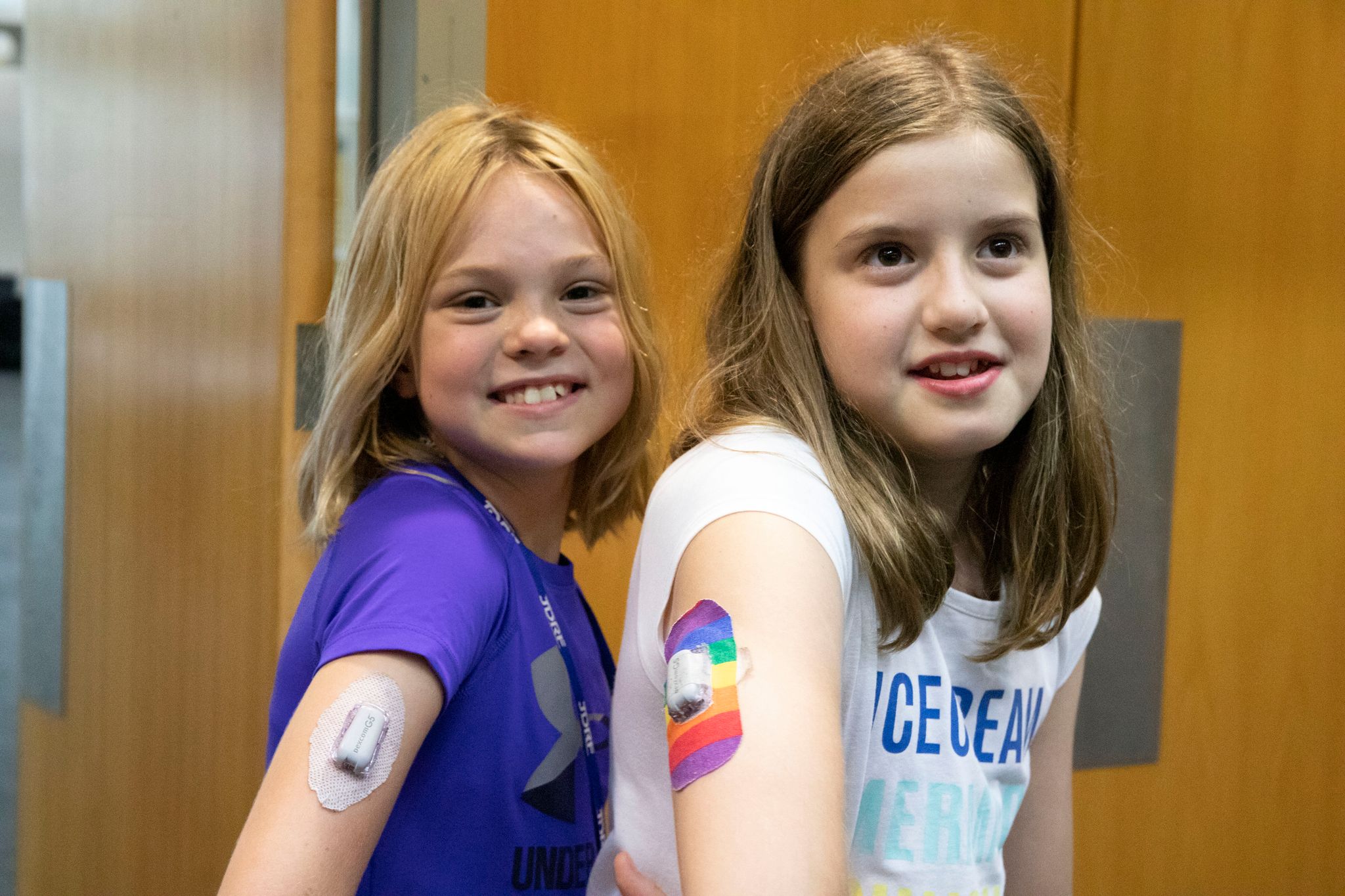Type 1 Diabetes Continuous Glucose Monitoring Devices
Join the One Walk Step Challenge to support type 1 diabetes research
SIGN UP NOW
Continuous glucose monitors

About continuous glucose monitors
A continuous glucose monitor (CGM) is a wearable device that continuously tracks glucose levels, day and night, allowing users to see patterns and trends. CGM units sound an alarm if blood glucose levels are changing rapidly, helping people avoid hypoglycaemia or hyperglycaemia. Currently there are two systems of continuous glucose monitors (CGM): real time CGM and flash glucose monitoring (flash GM).
Each system requires a sensor or a tiny electrode to be inserted under the skin. This is attached to either a transmitter or directly to the back of the upper arm. The electrode measures the level of glucose in the interstitial fluid in the tissue every 3 to 5 minutes. Depending which system is used, the sensor usually needs to be replaced every 6 to 14 days.
Real time CGMs
A real time CGM actively sends the glucose readings to a device, such as a mobile phone or insulin pump, and alarms can be set to alert when the sensor glucose level is too high or too low.
As measurements are taken every 3 to 5 minutes, the direction in which the glucose level is trending can be seen and some systems can alert up to 20 to 30 minutes before the sensor glucose is expected to be too high or too low, allowing some action to be taken beforehand. When used in conjunction with some insulin pumps, insulin delivery can either be stopped, decreased or increased based on the sensor glucose reading. This can have the added benefit of helping to prevent hypoglycaemia and hyperglycaemia with minimal input needed from the person living with T1D.
Read more about how hybrid closed-loop pumps work with CGMs.
Flash glucose monitoring
Flash glucose monitoring systems (flash GMs) store the readings on the sensor which is attached to the back of the upper arm. To view the collected data, you can scan the sensor with a phone or reader to view glucose readings and trends. The sensor can store data for the last 8 hours. This type of CGM is good at identifying day to day glucose patterns or trends. Some models cannot warn of impending highs or lows, but a newer flash model is available in Australia that does have optional alarms for high or low glucose levels or sensor loss.
Flash glucose monitors reduce the need for finger pricks, but they may still be required from time to time e.g. to check the accuracy of a reading before taking action.
You can read more about continuous glucose monitoring and flash glucose monitors on the NDSS website.
You can also compare the different CGM devices available in Australia.
The Continuous Glucose Monitoring Funding Initiative
![]()
17.6 million
Finger pricks avoided via JDRF's advocacy efforts that helped deliver the Government's Continuous Glucose Monitoring Funding Initiative.
![]()
12,077
People benefitting from the Federal Government's CGM Funding Initiative.
![]()
58,000
More people gained free access to CGMs as of February 2020.
The Continuous Glucose Monitoring Funding Initiative
CGM is not a cheap monitoring option and can cost between $2600 and $5000 a year. JDRF has been a strong advocate of access to CGM for many years and played a key role in developing the Diabetes Coalition, which lobbied government for the first round of funded CGMs. This helped establish the CGM Funding Initiative under which the Australian Government provides eligible people with access to fully subsidised CGM devices. In February 2020, the Government announced an expansion of the CGM Initiative allowing 58,000 more people to gain free access to these devices.
The CGM Initiative is administered by the National Diabetes Services Scheme (NDSS). To be eligible to access the subsidy, you must be assessed by an authorised healthcare professional and meet certain criteria. The full eligibility criteria are available on the NDSS website.
How is JDRF helping increase access to CGM?
The Australasian Diabetes Data Network (ADDN), established by JDRF, has captured data from 3915 people under 21 years of age, who commenced using CGM technology after the introduction of the government subsidy. The observed improvements in their lives will be part of presenting the value that CGMs can bring to the lives of people living with T1D.
The increase in funding for the CGM evaluation project will be valuable in the long term, as the funding, which extends the evaluation program until June 2024, will allow us to continue the important work of presenting the incredible impact CGM technology can bring, while also establishing evaluation as an important consideration to technology generally.
The Department of Health agreed to consider our proposal externally to the Budget process. The decision to champion the initiative through a time of considerable COVID-19 health spending reflects the value of the evaluation and the relationship JDRF has with decision-makers.
Access to CGM: Answering your questions
JDRF has played a key role in advocating for increased access to technology for all people living with type 1 diabetes (T1D). We get a lot of questions from the T1D community about JDRF's position on CGM and our advocacy efforts in this space. You can read our answers to some of your most frequently asked questions in our blog post.
Read more

I am interested in hearing more about…
Source: https://jdrf.org.au/living-with-t1d/continuous-glucose-monitors/
0 Response to "Type 1 Diabetes Continuous Glucose Monitoring Devices"
Post a Comment